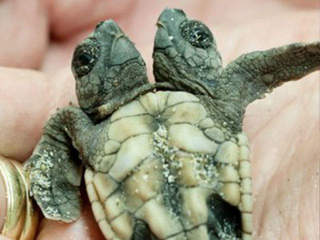JUPITER ISLAND — Simon Bilts must have done a double take when he found it in the sand: a two-headed loggerhead sea turtle hatchling.
On the morning of July 31, the biologist with Jensen Beach-based Ecological Associates was excavating a sea turtle nest on the northern end of Jupiter Island, Fla. that had hatched three days earlier to determine the reproductive success rate. It’s not unusual for a straggling hatchling or two to be found among the empty egg shells. It’s highly unusual for one of the hatchlings to have two heads.
“Yeah, two-headed hatchlings are kind of rare,” said Erik Martin, the scientific director at Ecological Associates. “I’ve only seen one before, back in 1984.”
Niki Desjardin, a senior scientist with Ecological Associates who’s been studying sea turtles for 11 years, said she’s seen two-headed specimens “maybe one or two times. And one was a dead two-headed embryo I found in a nest.”
Because this two-headed turtle was found after 9 a.m., Bilts brought it back to the Ecological Associates lab.
“If we find hatchlings later in the morning,” Martin said, “the state (Fish and Wildlife Conservation Commission) advises that they not be released until night. So that’s what we did.”
The day spent in a cool, dark area of the lab gave scientists there an opportunity to examine the rare find.
“He seemed to be relatively healthy,” Martin said. “Of course, its shell was somewhat deformed to make room for the two heads.”
Otherwise, the hatchling was active and able to crawl with both heads moving independently.
Only about one in 5,000 hatchlings living to adulthood, mostly because of predators both on the beach and in the water. Having two heads would seem to have both advantages and disadvantages for young sea turtles.
Advantage: Better peripheral vision.
“Hey, there’s a shark coming up on the left!”
Disadvantage: Potential for arguments.
“How about some crabs tonight?”
“Nah, I’m tired of seafood.”
Unfortunately, Desjardin said, two heads is not better than one when it comes to sea turtles.
“It puts a strain on the turtle’s internal organs,” she said. “And the fact is, you never see adult turtles with two heads.”
Sea turtle nesting season began March 1 and runs until mid-September.
Of the three species of sea turtles that regularly nest on Treasure Coast beaches, loggerheads are the most common but still are listed as a threatened species.
Nearly 10,000 loggerhead nests were tallied in 2011 by Ecological Associates, which monitors sea turtles nests in southern St. Lucie County, northern Martin County and northern Indian River County, and by the coastal engineering division of the Indian River County Public Works Department, which monitors beaches in the southern half of that county.
In the same areas, 1,652 green turtle nests and 558 leatherback nests were counted in 2011.
Martin said nest numbers “are looking good so far this year.”
http://www.kypost.com/







